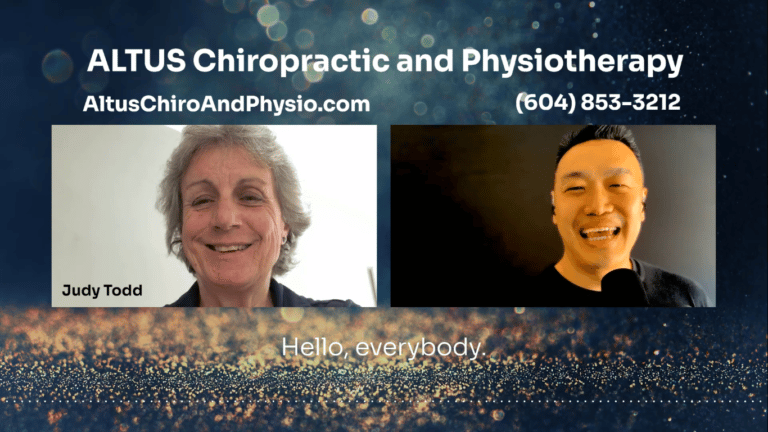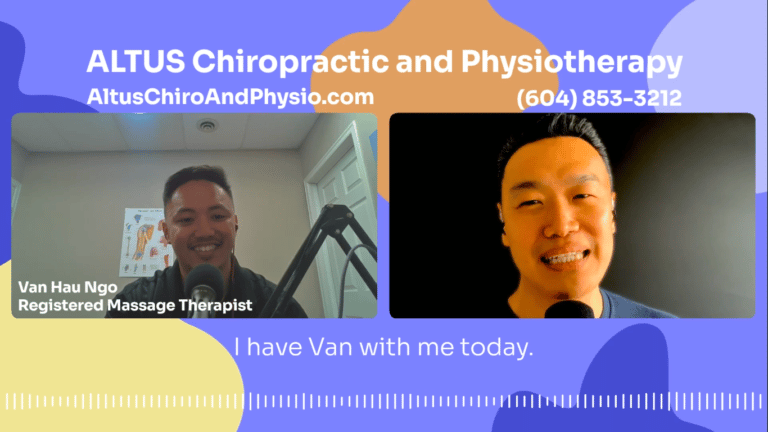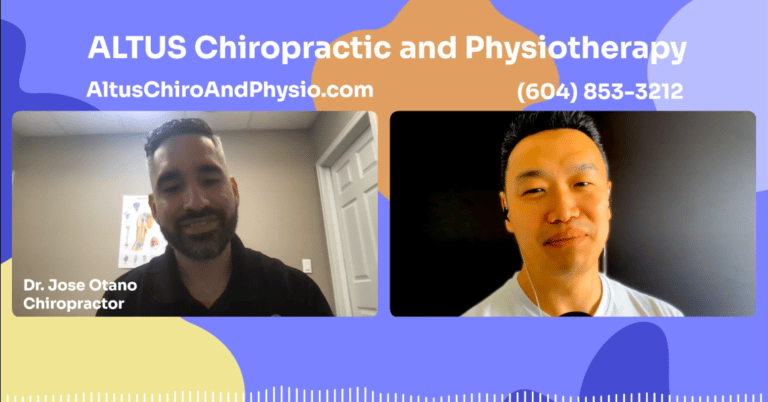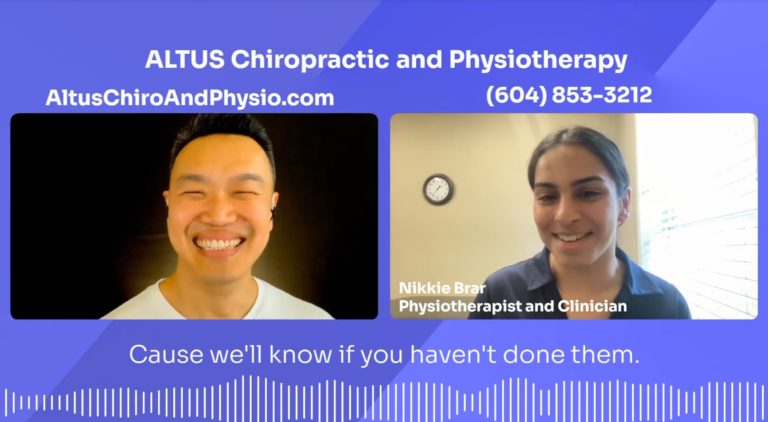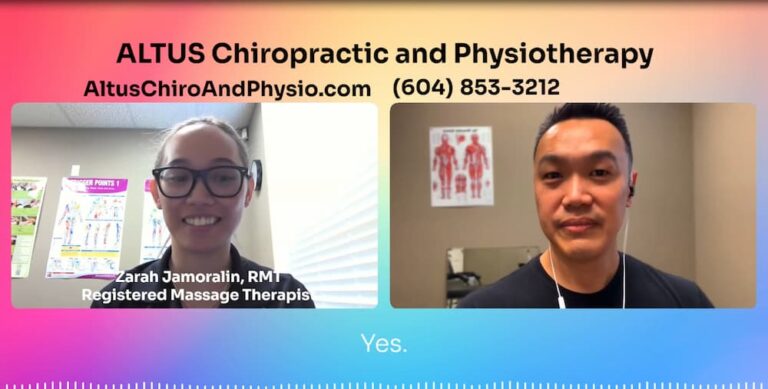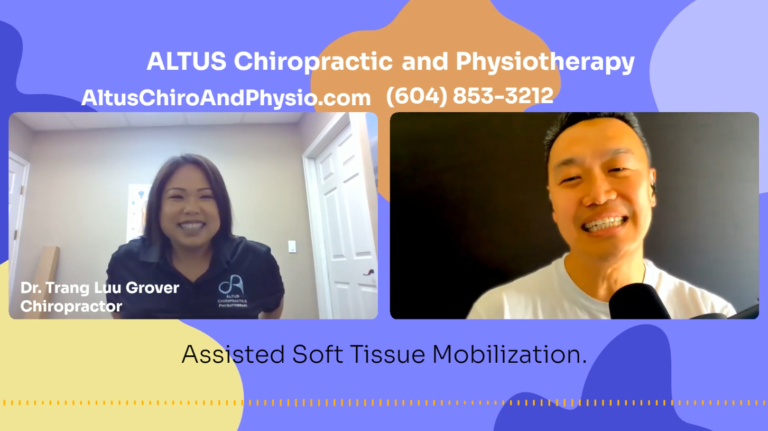Show Notes
[00:00:00] Sherman Hu: Welcome to today’s episode powered by ALTUS Chiro and Physio. Today we have Dr. Jose Otana with us. Jose, how you doing today?
[00:00:07] Dr. Jose Otano: Okay. Doing great.
[00:00:09] Sherman Hu: That’s awesome. I’m very excited about today’s episode because we are going to shock our audience with a wonderful topic called Shockwave Therapy.
What is Shockwave?
[00:00:18] Sherman Hu: What is Shockwave?
[00:00:19] Dr. Jose Otano: Basically, in general terms, is just an acoustic shockwaves that penetrates the bone or the soft tissue. And its effect is to reinjure that area so the body can prioritize it and start to heal it on its own. But it uses just sound waves that you see with a basic ultrasound machines. Like monitor imaging, such as looking at your baby, looking at the organs, but it uses it as a treatment modality.
Does Shockwave Therapy work?
[00:00:50] Sherman Hu: Okay. I’m sure this goes through the minds of many.
[00:00:54] Does it work?
[00:00:56] Dr. Jose Otano: Yes. So it was used back in the 1960s and seventies, [00:01:00] just to break down in a medical standpoint of breaking down gallstones or urinary stones.
[00:01:06] And, but way back then, and then in the later timeline, in the 1980s, “Should we use this for something else?”
[00:01:14] So that’s when they started doing it on orthopedic things, for hip replacements to break down the scar tissue. So that’s when the animal studies were coming down and then it wasn’t until the early two thousands it started being introduced in treatment settings for soft tissue or bone injuries. For sure it starts working, but it’s fairly new.
How new is Shockwave Therapy?
[00:01:35] Sherman Hu: How new is new based on what you’re saying?
[00:01:37] Dr. Jose Otano: In science, new is new within 20 to 30 years. Because you know how it is, it takes a long time for the research to catch up to it. Because we have to go through animal studies and then we can do clinical studies.
[00:01:51] And then after clinical, is randomized. So let’s just say that the earliest randomized control trial on this is 2015. [00:02:00] Where 2015, they found out that it is used for a lot of conditions for so many variations. And then the contraindications for it is pretty minimal. So it is fairly new.
[00:02:14] For those who are new to this phrase that you just mentioned, contraindication, that means in plain English?
[00:02:22] Reasons why we wouldn’t use it.
[00:02:24] Shockwave isn’t for everyone. It’s only for, I would say a very broad base of injuries and conditions, but there are a set of patients where it wouldn’t be good for.
What types of patients or clients should not use Shockwave Therapy?
[00:02:36] Sherman Hu: So the contraindications, like you don’t want to mix it with something else, is that correct?
[00:02:40] Dr. Jose Otano: Yes, because they have a disease. For example, the peoples that wouldn’t be beneficial for is if you had a malignant tumor or any circulatory disorders or blood disorders that prevent you from clotting.
[00:02:53] Or if you have osteoporosis, because your bones are fragile. You don’t to want to use it on those types of [00:03:00] people.
[00:03:01] As well as if the medical doctor is also using corticosteroid injections, like on the shoulder, for example, you don’t want to mess up with what the medical doctor is doing with those injections to hit it with Shockwave because it could also cause bad effect.
How long does it take for Shockwave Therapy?
[00:03:19] Sherman Hu: How long does it take for Shockwave Therapy?
[00:03:22] Dr. Jose Otano: It depends on the condition. Honestly, it does depend on the condition.
[00:03:25] And it depends if it’s acute or chronic.
[00:03:28] I can give you a general, broad answer to that.
[00:03:31] If it’s acute, you can see effect within one to three sessions.
[00:03:34] If it’s chronic, it can take about three to six sessions.
[00:03:38] And when I’m saying, how long it takes, that’s when they’ll notice significant improvements. That’s range of motion, more mobility, being able to do more things. Those are what I’m talking about with how long it takes to get effect.
What conditions can Shockwave Therapy treat?
[00:03:54] Sherman Hu: You mentioned conditions. So what conditions then can Shockwave Therapy treat?[00:04:00]
[00:04:00] Dr. Jose Otano: Research has shown that it is very effected against Plantar Fasciitis and any Tendinopathies or if there’s any calcium in the tendons.
[00:04:09] You also see it in people that have Osteoarthritis that we can use it on.
[00:04:14] Some lower back pain patients.
[00:04:16] Sacroiliac Joint patients.
[00:04:18] It does have some effect with people that have myofascial trigger points, that conservative care like massage therapy or just regular stretching doesn’t really do any effect on. So we can use it on things like that as well.
[00:04:33] Sherman Hu: I’m getting a sense for what it is and what you would treat it on.
How long should I rest after my Shockwave session? What should I not do? When can I return to regular activity?
[00:04:38] Sherman Hu: If I have shockwave treatment from you, what should I not do after my shockwave session? Or how long should I rest after the therapy? And when can I return to regular activity?
[00:04:50] Dr. Jose Otano: That’s a very common question that I get.
[00:04:52] You want it to take effect, because like I said in the beginning that the point of it is to reinjure [00:05:00] the area in a cellular level. So it doesn’t really cause too big of an injury to that area, but it does create soreness. That soreness is something that is going to limit your physical activity.
[00:05:11] So you shouldn’t be doing a big, intense workout. After shockwave, you shouldn’t go to the gym.
[00:05:17] You should go home and do a simple stretch, simple mobility program that kind of facilitates the Shockwave and can continue getting the blood flow going, but nothing too drastic.
[00:05:29] Keeping it at a light to moderate intensity of a exercise program, a walk, anything like that can be great for it.
[00:05:39] But running afterwards or going for a marathon run. Yeah. That would be too extreme.
[00:05:44] Want to give it a good rest that day and then the next day feel how you’re feeling and see, and then tolerate a little more, do that moderate… maybe you can start doing the exercise, but don’t push yourself too much.
[00:05:59] Sherman Hu: Okay, so no [00:06:00] Ironman?
[00:06:01] Dr. Jose Otano: No Ironman. Or CrossFit.
[00:06:04] Sherman Hu: Or CrossFit. Yeah.
How much time between Shockwave sessions?
[00:06:05] Sherman Hu: Are you recommending patients or clients give it 48? 72 hours?
[00:06:10] Dr. Jose Otano: Ideally we could go within 24 to 48 hours in between sessions because you do need to know how your body handles the Shockwave. Some patients have different responses than others.
[00:06:22] But 24 to 40 hours is the minimum between sessions and then the maximum, research says it’s about a week.
[00:06:30] You don’t want to go more than a week between the sessions, especially when we’re dealing with recovery or healing.
How long between my Shockwave session to when I can go to the gym?
[00:06:37] Sherman Hu: Between my session to when I hit the gym again, what kind of rest time?
[00:06:44] Dr. Jose Otano: That one is patient dependent. I would love them to at least take a couple hours break after the session. Go home, just rest.
[00:06:53] And then after the session, if they wanted to go to the gym and do a light mobility program. Remember Shockwave [00:07:00] Therapy is coupled with whatever a therapist gives them, such as hip mobility or shoulder mobility program. Something that gets them moving. And that program design that therapist has given them should be light to moderate so they can scale it.
[00:07:15] And that should be done that same day as well.
Is the Shockwave treatment painful?
[00:07:18] Sherman Hu: You mentioned breaking the scarring or whatever the issue is down on a cell level. Does it mean that the therapy itself is painful during treatment? Or why is it painful?
[00:07:30] Dr. Jose Otano: That’s also another big question that I get from my patients as well when they first get Shockwave.
[00:07:35] Is that during the session, it can be a little bit discomforting, but it’s up to the patient and the therapist to work on the start of the intensity. So for me, I always start it at the very mild intensity and we start it there.
[00:07:50] Because what it is, it does use sound waves to increase pressure to the area. When it increases pressure to the area, it’s not a [00:08:00] constant pressure. It is pulsated pressure that you will experience.
[00:08:04] And the frequency depends on the machine, but it does feel discomforting and then we do need it to be tolerable for the patient. So it’s not painful, but it should be tolerable for them.
[00:08:16] So that is all objectively done with the machine where I can gauge it, start off very mild, and then I start ramping it up on the level of comfort for my patient. So it’s tolerable.
[00:08:31] Sherman Hu: Reminds me of the “Hot Ones” where you scale up from mild chicken wings to “Da Bomb” or “The Dab”.
[00:08:41] Dr. Jose Otano: And then they have you sign a consent form for the very hard one. That’s concerning.
[00:08:45] Sherman Hu: It will hurt you from behind for life.
[00:08:49] Dr. Jose Otano: Yes, exactly. I hope that this isn’t the same though.
Are there any post-Shockwave-session effects?
[00:08:55] Sherman Hu: Now what are things that I will experience immediately after the session?[00:09:00]
[00:09:00] Dr. Jose Otano: Very rarely there could be bruising, some redness and some achiness afterwards. And that is rare. I see that in maybe one in 10 patients. The soreness or achiness that they describe, it feels like a toothache. And it’s very short lasting and may last a couple of hours or that whole day. But then it subsides and the next day is gold. But again, that’s rare.
[00:09:21] Most patients, what they’ll experience is just a general soreness and that soreness is explained to me as “It feels like I just came from the gym. Like I worked out biceps too much that day”.
[00:09:34] Sherman Hu: Oh, okay. Does it feel like DOMS (Delayed Onset Muscle Soreness)?
[00:09:39] Dr. Jose Otano: No, it feels…
[00:09:40] Sherman Hu: …like way before DOMS, type of feeling?
[00:09:43] Dr. Jose Otano: Yes. It feels like a fatigue muscle soreness at the gym.
[00:09:47] Sherman Hu: Okay. That’s fair. That’s good.
[00:09:49] Dr. Jose Otano: Yeah. Like your personal trainer’s kinda pushing you. That’s the point of the shockwave, is to build it to the tolerance. So then your body prioritizes it. So it’s going to create some soreness that same day. [00:10:00]
Is Shockwave Therapy embraced by family doctors?
[00:10:00] Sherman Hu: Okay. Is shock with therapy embraced by many family doctors? Because I would assume if they’re not, then patients or clients would not have heard about it from their family doctor?
[00:10:15] Dr. Jose Otano: When I introduced Shockwave, I said it was used to break down gallstones and urinary stones. And for the medical standpoint, that’s what they think of.
[00:10:24] They don’t really think of it as the conservative care that physiotherapists and chiropractors are using it for.
[00:10:30] They’re thinking, “Oh, Shockwave. No, you don’t have a bladder stone. Why would we use it on your shoulder?”
[00:10:35] So they’re kind updated medical knowledge is with that. So when you talk to your family physician, that’s what they’re thinking of. So it’s not that they don’t know about it, is that they have other usage for it.
[00:10:49] Sherman Hu: In different context.
[00:10:50] Dr. Jose Otano: Yes. It’s in a different context. But once he tells them about it, or we tell the medical doctor about it, just to look up the latest research about it. They’re like, “Yeah, [00:11:00] for sure. This sounds legit. We should for sure try this on that shoulder case before surgery”. Or on a knee case before that surgery, just to see if it works.
[00:11:09] But yeah, that’s the general basis of it is they think of it in another context, then us physios and chiros use it for.
[00:11:19] Sherman Hu: Okay.
Top 3 types of clients that should not use Shockwave Therapy
[00:11:20] Sherman Hu: You mentioned early on some of the folks that should not be seeking treatment for Shockwave because of their existing issues or situations, can you repeat again, the top three types of folks that should not be seeking treatment?
Type 1: Circulatory disorder or blood disorder
[00:11:36] Dr. Jose Otano: Any patient that has a circulatory disorder or a blood disorder that can’t regulate their bleeding because they can’t clot properly. That’s number one.
Type 2: Infections or Cancer
[00:11:46] Dr. Jose Otano: Any presence of infection to the area: sepsis, or any kind of bone infection or anything like that. You don’t want to do it on that either. Over- cancerous sites, if there’s someone that has bone [00:12:00] cancer, you obviously don’t want to put the Shockwave over that.
Type 3: Not over Abdominal Cavities, Heart, Stomach
[00:12:03] Dr. Jose Otano: And then last but not least, the major one would be not over any abdominal cavities, like over top of your heart or over top of your stomach and stuff like that. You don’t want to do it over those areas as well.
[00:12:17] Sherman Hu: Okay. So you mentioned bone cancer. If somebody is listening to this or watching this and they go, I don’t have bone cancer, but I have cancer of a different body part… that included too, right?
[00:12:29] Dr. Jose Otano: Yeah. So unless if they’re in remission or the cancer has been removed, then we can ask the medical doctors to see if they are a candidate. Because we always want to keep them in the loop as well. Because we don’t want to mess up with any guidelines that they have. But if they’re in remission or the cancer has been removed, then we can definitely talk about Shockwave.
[00:12:52] But if they are currently getting treatment for their cancer, it’s better to be safe and let it be dealt with from [00:13:00] the medical.
Are there side effects with Shockwave Therapy?
[00:13:00] Sherman Hu: Okay, that sounds great. Now, are there any side effects to Shockwave therapy?
[00:13:07] Dr. Jose Otano: No, there is no long-term side effects to it. Short-term, like I said, just the soreness and then rare cases, the redness, bruising and aches. But there is no long-term side effects.
[00:13:19] Because, like I said, it uses acoustic waves to shock the area. And they’ve been doing this since the 1960s and seventies, and then they also use it for imaging. So it’s the same type of kind of content or ways of doing it.
How many sessions would I need?
[00:13:34] Sherman Hu: Okay. Do you also get asked by clients how many sessions they would need? I would assume based on how acute or chronic?
[00:13:43] Dr. Jose Otano: Yeah, for sure. I always like to make sure that the patients don’t get too dependent on a treatment because honestly, mobility and getting them walking and doing their own exercises at home is the most important, than to rely on a external [00:14:00] treatment source.
[00:14:00] So I always tell patients that if we don’t see significant gains within three to six sessions, then this might not be for you.
[00:14:09] Let’s say we do see significant improvements between three to six sessions. And they are also doing their home exercises. And they’re walking and they’re back to normal, then at the six session mark, we evaluate. And we say, at a percentage, how healed are you? 80%? 90%? Or a hundred percent healed? And if they say in that ballpark between the high eighties and nineties, then I’ll say,
[00:14:34] “Okay, do you think you can carry it on? Or do you need one or two sessions?”
[00:14:38] And then we discuss it as a practitioner and patient. And then if after that they are a hundred percent, then I say, “Let’s take a pause. Let’s wait a couple of weeks. Wait a month. We’ll follow up. If you need more sessions, we’ll definitely discuss it.”
[00:14:54] But honestly, the point of the Shockwave is just to get ahead, for them to do those [00:15:00] home exercises, those gym exercises, and go for walks again.
Shockwave Therapy Client Case Study: Plantar Fasciitis
[00:15:05] Sherman Hu: Okay. What’s one example of a client case study where you’ve been quite impressed with the before / after?
[00:15:16] Dr. Jose Otano: Yeah. The best ones are my plantar fasciitis cases. Those are the ones that come in saying that they have plantar fasciitis and then dealing with it for months and their doctors and their therapists have tried everything.
[00:15:28] They’ve tried to rest, but because these are active bodies, they can’t stop working. They have to be on their feet. They can’t necessarily rest, because that’s essentially the gold standard.
[00:15:38] But they come in. We do two, three sessions. Their plantar fasciitis is gone. They’re able to get ahead of it, to do the exercises, then boom, they stop coming after three sessions and I’m ecstatic about that.
Shockwave Therapy Client Case Study: Bilateral Patellar Tendinopathy
[00:15:52] Dr. Jose Otano: But my best one is Bilateral Patellar Tendinopathy.
[00:15:57] So gruesome knee pain. She’s 25 years [00:16:00] old and she saw a orthopedic surgeon. And the orthopedic surgeon x-rayed her, did the exam. Before that, they didn’t know what was causing her knee pain. They did the x-ray. Found that it is Plantar Fasciitis.
[00:16:14] “I’m sorry, but you just have to see physiotherapy. There’s nothing more we can do for it”.
[00:16:20] So she saw physiotherapy and she said it wasn’t getting the job done. And she was suffering with this for over a year because it takes about a year to see the surgeon. So she was suffering for a long time.
[00:16:32] And then just last month, where I was like, “Let’s do some Shockwave.”
[00:16:36] So we did Shockwave. I gave her exercises.
[00:16:40] After five sessions, five sessions. She says, “I can now go up and down the stairs without any pain.”
[00:16:46] She says, “It is a little soon”. She’s not telling her boss yet, but she’s able to now do more work at work now.
[00:16:54] Sherman Hu: That’s incredible.
[00:16:56] Dr. Jose Otano: And she’s only 25 too!
[00:16:57] Sherman Hu: That’s the shocking part. So [00:17:00] young!
[00:17:00] Dr. Jose Otano: It is, yeah, so young and she saw a specialist about it as well.
How much does Shockwave Therapy cost?
[00:17:04] Sherman Hu: Yeah. Okay. I have one final question and I’m sure folks are thinking in their mind, “I’d like this. It sounds great. I think it could work for me, maybe. But how much does it cost?”
[00:17:15] And I know you have different machines and types, but what’s the ballpark range?
[00:17:19] Dr. Jose Otano: So the ballpark range is around the $80 range. It can be $5 to $10 more depending on the clinic, and depending on the location that you’re living in. Vancouver might be a little bit more. But from the two clinics that I work, out here in Abbotsford and in Chilliwack, we charge about $80 and we charge it as like a session.
[00:17:39] During the session time, we will do Shockwave. But if you also need other treatment as well, we will add it on to it. So the Shockwave with Chiropractic session. So it will be added into it.
[00:17:51] But if you only wanted Shockwave, between the two clinics, it’s about $80.
[00:17:56] Sherman Hu: If I’m hearing you, Shockwave is part of the Chiropractic [00:18:00] session. And is that $80 an add-on to the Chiro fee?
[00:18:05] Dr. Jose Otano: Yes. Exactly. So for example, if a patient wants additional. For example, some mobility on their back or their neck or something like that, in addition to the Shockwave, then it would be a Chiropractic subsequent session with Shockwave. So it would be added on to it.
[00:18:21] But if they just wanted Shockwave, they just wanted to get the treatment on their plantar fasciitis or their tendinopathies, or anything like that, then it would just be that $80 session.
Is Shockwave Therapy covered by my extended health benefits?
[00:18:33] Sherman Hu: Let’s say I have a benefits package that covers Chiro, will that be covered because that’s part of my chiropractic?
[00:18:39] Dr. Jose Otano: It all depends on your extended benefits. You would have to double check with your extended benefits, and it’s as simple as just calling the number on it.
[00:18:47] Some of them have different coverages for it, but majority of the time, I believe that they will cover it. But it is between the patients and their extended benefits. So they would have to call in ahead of [00:19:00] time just to make sure.
[00:19:02] Sherman Hu: This is shocking news because this is the first time I’ve had so much intel on Shockwave Therapy. So I thank you. A lot of viewers and listeners will I’m sure appreciate you answering all these questions that probably are going through their mind too as they hear about Shockwave Therapy.
[00:19:20] Dr. Jose Otano is at ALTUS Chiro and Physio in Abbotsford.
[00:19:27] Can you share with our listeners or viewers where ALTUS is located in Abbotsford?
[00:19:33] Dr. Jose Otano: We’re on Ventura Avenue, off of South Fraser Way. If you’re from Abbotsford, it’s just across the street from the McDonald’s on South Fraser Way. So it’s on Ventura Avenue.
[00:19:44] Sherman Hu: Perfect. Thank you so much for your time. And I look forward to the next time we get a chance to chat more about chiropractic treatments.
[00:19:53] Thanks for staying tuned to this podcast today. Stay tuned for next week’s episode, where we’ll cover more [00:20:00] Chiro and Physio topics, powered by ALTUS Chiro and Physio.

